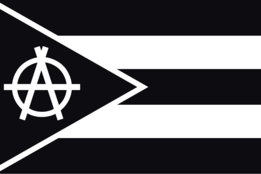
| Part of a series on |
| Anarchism |
|---|
 |
Anarchism as a social movement is one of the manifestations of the political left within the working classes of Puerto Rico, having its peak during the late 19th and early 20th century. Anarchism was predominantly present within, but not exclusive to, the working classes that emerged as the sociopolitical environment changed.[1] The municipalities of Caguas and Bayamón were the epicenters of the movement.[2] It was also recorded in other industrial centers, such as Ponce, San Juan, Arecibo, Cayey, Cidra, Juncos, Vega Baja, Utuado, Lares, Yauco and Mayagüez.[2] Despite sharing some core values, Puerto Rican anarchism was heterogeneous in nature.[3] In general, Puerto Rican anarchism was distinctly anti-organized religion, in particular against the Catholic Church that had retained considerable influence since the beginning of Spanish colonialism.[4] Following the Treaty of Paris, it also grew to oppose American sovereignty, as it perceived that the island was being forced into servitude with an Americanization initiative, leading to distinct antiauthoritarian stances against both foreign and local politicians, the wealthy higher classes and American labor unions.[4] However, on principle (as an opposition to nationalism, which was viewed as a manner for the state to consolidate power) the anarchists opposed joining the independence movement.[5]
During the early 20th century, anarchists were considered a small, but active, minority within the Puerto Rican left.[6] The movement attracted women, particularly younger ones, who felt unsatisfied within what they considered a predominantly "patriarchal society".[7] Initiatives were made to create schools for the uneducated fraction of the population.[7] It also faced unique circumstances among the Latin American anarchist movements, operating under an American colonial administration (whereas all of the others operated in a post-colonial or neocolonial environment), by not conforming to particular ethnic groups and by lacking an influx of Spanish anarchists after 1898.[8][9] They still opposed organizations that represented Spanish power, such as was the case in 1912, when they participated in an anti-Church campaign led by anti-clerical activist Belén de Sárraga.[4] As part of their internationalist ideals, Puerto Rican anarchists would denounce the working conditions in places abroad, such as Tampa.[10] Ultimately, defection of leaders and government intervention mined Puerto Rican anarchism. Some like Iglesias Pantín did it early and formed an alliance with the AFL, eventually becoming a socialist senator in 1917.[11]
The union's ties with the AFL distanced it from the anarchist roots of Spanish syndicates, from which the local working class had been linked.[12] The former formally adopted a liberal ideology that mirrored their associate.[13] However, with it also came an anti-anarchist sentiment that was predominant within the higher echelons of the AFL.[13] Romero Rosa moved away from anarchism as he made his move to party politics, being elected in 1904.[11] On March 9, 1911, Vilar in representation of the CES lead the tobacco worker's strike at Caguas.[14] During the late stages of the event, two wealthy citizens were shot.[14] The colonial authorities responded by intervening with a number of anarchists, leading to reports of torture.[14] The suspect was eventually tried and found guilty of first degree murder.[14] Vilar was not accused in this case, but the colonial authorities decided to charge him for violating the public morality codes, after he denounced a case of child abuse by a member of the clergy.[14] In 1915, Vilar died while serving the year sentence for which he was convicted.[14] The event led to a crisis in which several leaders either migrated or left for more moderate causes. Another fraction of the Puerto Rican anarchists would migrate to political organizations, such as the Partido Socislista.[15] Figures like Romero Rosa would be lost, in his case becoming increasingly conservative and abandoning his previous political stance.[16]
- ^ Meléndez 2015, pp. 29
- ^ a b Meléndez 2015, pp. 154
- ^ Meléndez 2015, pp. 187
- ^ a b c Schaffer 2013, pp. 2
- ^ Schaffer 2013, pp. 18
- ^ Schaffer 2013, pp. 171
- ^ a b Cite error: The named reference
Schaffer1was invoked but never defined (see the help page). - ^ Schaffer 2013, pp. 6
- ^ Cite error: The named reference
Schaffer7was invoked but never defined (see the help page). - ^ Cite error: The named reference
Schaffer74was invoked but never defined (see the help page). - ^ a b Cite error: The named reference
Schaffer15was invoked but never defined (see the help page). - ^ Meléndez 2015, pp. 101
- ^ a b Cite error: The named reference
Meléndez107was invoked but never defined (see the help page). - ^ a b c d e f Schaffer 2013, pp. XV
- ^ Cite error: The named reference
Meléndez192was invoked but never defined (see the help page). - ^ Cite error: The named reference
Meléndez105was invoked but never defined (see the help page).
© MMXXIII Rich X Search. We shall prevail. All rights reserved. Rich X Search
